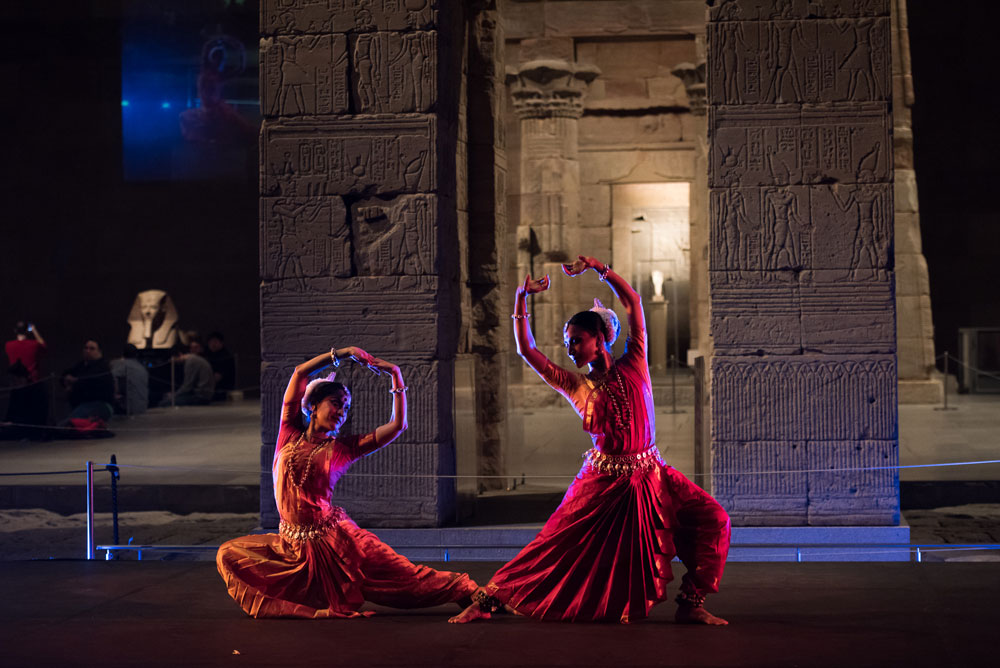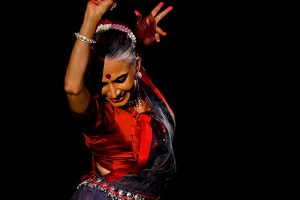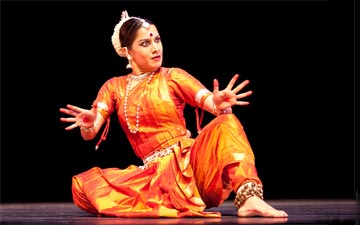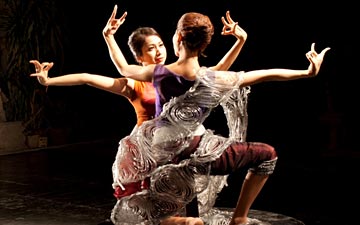
© Nan Melville. (Click image for larger version)
Nrityagram Dance Ensemble
Shyamala Vandana, Dhira Samiré, Vibhakta
New York, Metropolitan Museum of Art
10 January 2015
www.nrityagram.org
www.metmuseum.org
Odissi at the Met
In an inspired collaboration with the World Music Institute, the Metropolitan presented two dancers from the southern-Indian ensemble Nrityagram, Surupa Sen and Bijayiny Satpathy, at the Temple of Dendur on Saturday. Even before Satpathy and Sen came onstage the mood was electric. The large space around the Egyptian temple, which faces a wall of windows facing onto Central Park, was filled to capacity with people of all ages, standing and sitting and jostling for a better view of the stage. The square performance space had been placed just in front of the free-standing carved sandstone temple gate, with the body of the temple behind it; the marble platform on which the temple stands is framed by a thin stream of water. The Nile by way of Manhattan.
I caught the first performance at 5 in the afternoon (there was another at 7). As the four musicians began to warm up their instruments, the sky over the city was just beginning to grow dark. More than a dance performance, the atmosphere was that of an outdoor festival. A most appropriate setting for Odissi, a dance whose origins lie in and around the ancient temples of Odisha, as far back as the 2nd century BCE.
The walls of these temples are covered with reliefs depicting the poses of the devadasis, or holy dancers, attesting to Odissi’s ancient roots. But the actual ritual dance form was practically lost by the beginnings of this century, when it was revived by a handful of gurus. (For centuries an impoverished version of the dance had been conserved by Gotipuas, young male dancers who performed during folk festivals.) Sen, a student of Guru Kelucharan Mahapatra – one of the architects of modern Odissi – has spent her career studying the form and extending it through her own choreography. One of her innovations has been the creation of ensemble choreographies, and, more recently, the extraordinary sophistication of her collaborations with Satpathy, with whom she was worked for over twenty years. The performance at the Metropolitan featured three duets with Satpathy, one of them new.

© Nan Melville. (Click image for larger version)
The two have a striking connection; at times their bodies seem to merge into one idealized and multi-dimensional figure, lines curling and curving around each other. Their musicality and coordination can be thrillingly synchronized, as when the two took small, pattering steps, one just ahead of the other, around the stage space. We begin to doubt our eyes; can two beings move in such harmony? At others, they seem to engage in playful give-and-take, tossing phrases from one part of the stage to another, reacting or responding, and tossing them back. The two women can also be strikingly distinct; generally Satpathy is the more sensual of the two, in what is already one of dance’s most sensual forms, all rounded shapes, inviting glances and lilting sways of the upper and lower body. Satpathy has the more serene and beguiling smile and the most tantalizing eyes. Her eyes seem to cradle and cajole every member of the audience individually. I attended the performance with two friends; each was convinced that she had danced for him alone.
In contrast, Sen’s movements are stronger, more decisive and sculptural, almost masculine at times. Her humor is less cajoling, more forthright. She is most imposing in her statue-like stillness. Odissi is not only a dance but also a story-telling form, in which steps, gestures, and facial expressions enact stories of the Gods. Many involve both male and female characters and the qualities they embody. In Dhira Samiré, the second piece of the evening, the two dancers enacted the seduction of the milkmaid Radha by the god Krishna – a frequent theme in Indian classical poetry and dance. Sen, as Krishna, lay on the floor, daydreaming. (But Sen never tried to create the illusion of not being a woman; she was the god and herself, all at once.) Behind her Satpathy mimed plaiting her hair into a braid, with flirtatious anticipation. Sen (as Krishna) seemed to be conjuring her consort with her imagination; she could feel the presence of the young woman behind her. The mere sensation of her proximity filled her pleasure.
In expert hands Indian dance often produces this cinematic effect, like watching a story unfold on split screens. Sen mimed playing the flute, and Satpathy’s entire body vibrated to the sound. At the end, they walked off hand in hand, lovers eagerly united. But, surprise! At the last minute Satpathy pulled away, still haunted by the sound of Soumyaranjan Joshi’s flute. She kneeled, eyes sparkling, transfixed by the sound.
The third and final piece, Vibhakta, expanded on the theme of the conjoining of feminine and masculine energy. The two have performed it before in New York, as part of an evening entitled Samyoga. The piece is almost startling in its intimacy and erotic charge. At times, Sen and Satpathy seem to dance for each other’s pleasure, facing each other, or back to back, or in close physical proximity. It is a celebration of the two women’s deep technical and no doubt philosophical connection. To denote this, Sen has devised a series of interlocking poses: one woman hovering over the other, the other kneeling and arching into a deep backbend; one woman’s foot hooked into the crook of the other’s knee.
For those with an unencumbered view of the dancers, the rewards of observing their gestures and expressions – or abhinaya – at close range were great. Every quivering eyebrow, half-smile, and shimmer of the fingers registered powerfully, almost physically, in the viewer. One could admire the extreme control required to flow from one pose into the next, to tilt and bend with sensual slowness and hold positions without betraying strain, while appearing to inhabit another realm. One followed the story almost with bated breath. Odissi has fewer quick-footed pure-dance passages than other Indian dance forms, but it hardly matters when the intensity of the performance is so engrossing. Jateen Sahu’s voice and Soumyaranjan Joshi’s flute, amplified to fill the large space, added immeasurably to the spell. It mattered not at all that the temple was Egyptian, the dances were Indian and all this was taking place at a museum in the middle of New York City. In fact for a moment, nothing else mattered at all.

















You must be logged in to post a comment.